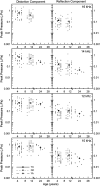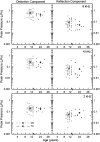Descriptive Characterization of High-Frequency Distortion Product Otoacoustic Emission Source Components in Children
- PMID: 37467378
- PMCID: PMC10555457
- DOI: 10.1044/2023_JSLHR-23-00013
Descriptive Characterization of High-Frequency Distortion Product Otoacoustic Emission Source Components in Children
Abstract
Purpose: Distortion product otoacoustic emissions (DPOAEs) provide an objective assessment of cochlear function and are used for serial ototoxicity monitoring in pediatric cancer patients. DPOAEs are modeled as having distortion (near f2) and reflection (near 2f1-f2) component sources, and developmental changes are observed in these components' relative strengths in infants compared with adults. However, little is known about source component strengths in childhood or at extended high frequencies (EHFs; > 8 kHz). Thus, the purpose of this study was to describe the effects of age and stimulus frequency on DPOAE components in children.
Method: DPOAEs were collected with varied frequency ratios (f2/f1 = 1.1-1.25) for a wide range of frequencies (2-16 kHz) in 39 younger (3-6 years) and 41 older (10-12 years) children with constant levels (L1/L2) of 65/50 dB SPL. A depth-compensated simulator sound pressure level method of calibration was employed. A time waveform representation of the results across various ratios was created to estimate peak pressures and latencies of each DPOAE component.
Results: Estimated peak pressures of DPOAE components revealed the greatest differences in DPOAE sources between children occurring at the highest frequencies tested, where the peak pressure of both components was largest for younger compared with older children. Latency differences between the children were only noted at higher frequencies for the distortion component.
Conclusions: These results suggest that DPOAE levels decrease with age and reflection emissions are vulnerable to cochlear change. This work guides optimization of protocols for pediatric ototoxicity monitoring, whereby including EHF otoacoustic emissions is clearly warranted and choosing to isolate DPOAE sources may prove beneficial.
Supplemental material: https://doi.org/10.23641/asha.23669214.
Figures









References
Publication types
MeSH terms
Grants and funding
LinkOut - more resources
Full Text Sources
Miscellaneous

